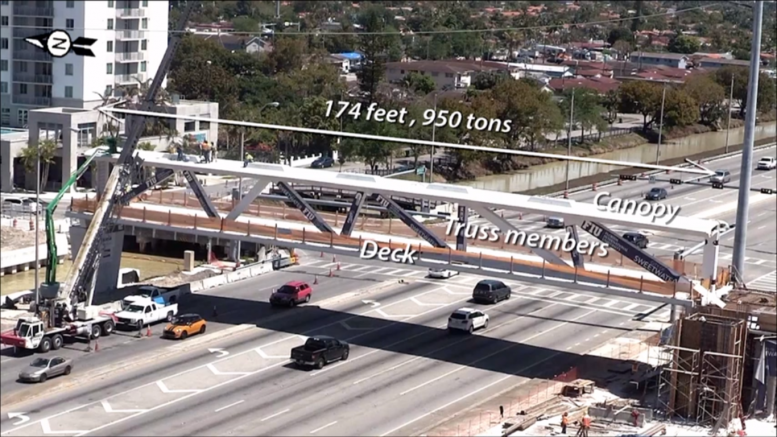By: Joshua Ceballos/Investigative Editor
This article was updated with additional information regarding FDOT and FIGG from the NTSB meeting.
The fatal collapse of the FIU pedestrian bridge was caused by FIGG Engineering Group’s decisions and their failure to get oversight. FIU could have suspended the project, but did not, according to the National Transportation Safety Board.
The NTSB concluded in their investigation that the collapse, which killed six people on March 15, 2018, happened due to FIGG’s choice to tension parts of the bridge that had severe cracks, causing a “blowout.”
“Retensioning provided additional force across compromised areas, resulting in the collapse,” said Steven Prouty, senior vehicle factors engineer for NTSB.
Cracks were found on the node of the 11 and 12 truss structures on the north side of the bridge as early as Feb. 24, and by March 15 they were 40 times larger than the acceptable range. The cracks grew continuously for five days. FIU, FIGG, the Florida Department of Transportation, the construction company, and engineering consultant Bolton Perez all could have stopped the project, but none did despite clear signs of trouble.

Cracks on the Number 11 support truss were 40 times larger than acceptable by March 14, 2018, the day before the collapse. Photo courtesy of NTSB
To address the problem, FIGG’s Engineer of Record chose to retension the steel rods in the problem area on March 15.
“Retensioning was a change to construction plans that should have been reviewed and signed off on by a professional engineer, but that was never done,” said Prouty.
Another faulty decision by FIGG was to instruct Munilla Construction Management to place a support stack in the center of the bridge but not to lift the bridge. According to NTSB investigators, no significant stress could have been taken on by the stack without lifting.
The cracks themselves were only a symptom of FIGG’s questionable design. The bridge was designed without redundancy, meaning if only one truss broke, the entire thing was doomed to fail. The design also overestimated the bridge’s load capacity, meaning their calculations for what the bridge could handle were completely off.
All parties involved, including FIU, had authority to close the road during construction and retensioning, but failed to do so.
FDOT was hands-off on the project and delegated responsibility to FIU through a Local Agency Program agreement, but the NTSB said they should have had more oversight on the project considering the complexity of the bridge and the University’s lack of experience. The board is recommending a change to FDOT’s policy that will require more hands-on involvement with complex projects.
NTSB Board Member Jennifer Homenday also admonished FIU and the other parties for a letter sent to the board on Saturday, Oct. 5 asking that the NTSB delay the release of documents related to their investigation.
In the letter signed by University Chief Financial Officer Kenneth Jessell and representatives from FIGG, MCM, Bolton Perez and Structural Technologies, the parties pleaded with NTSB to not release the docket on Oct. 8 because it may affect settlements for the families involved in litigation about the bridge.
Homenday said this letter was “shocking and disappointing,” and the NTSB responded by saying “the NTSB cannot delay release of critical safety information to accommodate the needs of private litigants.”

Screenshot of Letter sent to NTSB requesting that they not release a public docket of information before Oct. 21.
Additional reporting by Dalton Tevlin and Valentina Palm/PantherNOW Staff






Be the first to comment on "NTSB: Bridge Collapse Caused by FIGG’s Decisions, FIU Could Have Stopped It"